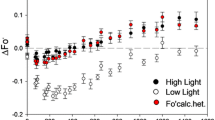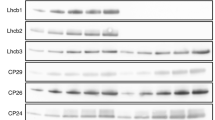Abstract
Analysis of the partitioning of absorbed light energy within PSII into fractions utilized by PSII photochemistry (ØPSII), thermally dissipated via ΔpH-and zeaxanthin-dependent energy quenching (ØNPQ) and constitutive non-photochemical energy losses (ØNO) was performed in wild type and F2 mutant of barley. The estimated energy partitioning of absorbed light to various pathways indicated that the fraction of ØPSII was slightly higher, while the proportion of thermally dissipated energy through ØNPQ was 38% lower in F2 mutant than in WT. In contrast, ØNO, i.e. the fraction of absorbed light energy dissipated by additional quenching mechanism(s) was 34% higher in F2 mutant. The increased proportion of ØNO correlated with narrowing the temperature gap (ΔT M) between S2/3QB− and S2QA− charge recombinations in F2 mutant as revealed by thermoluminescence measurements. We suggest that this would result in increased probability for an alternative non-radiative P680+QA− radical pair recombination pathway for energy dissipation within the reaction centre of PSII (reaction center quenching) and that this additional quenching mechanism might play an important role in photoprotection when the capacity for the primary, zeaxanthin-dependent non-photochemical quenching (ØNPQ) and state transitions pathways are restricted in the absence of LHCII polypeptides in F2 mutant.
Similar content being viewed by others
Abbreviations
- LHCII:
-
the major Chl a/b pigment-protein complex associated with PSII
- PSI:
-
photosystem I
- PSII:
-
photosystem II
- QA :
-
primary electron-accepting quinone in PSII reaction centres
- QB :
-
secondary electron-accepting quinone in PSII reaction centers
- NPQ:
-
non-photochemical quenching
- qL:
-
photochemical quenching
- TL:
-
thermoluminescence
- TM :
-
temperature maximum of the TL emission peak
References
Allen, J.F. (1995). Thylakoid protein phosphorylation, state 1-state 2 transitions, and photosystem stoicheometry adjustment: redox control at multiple levels of gene expression. Physiol. Plant., 93: 196–205.
Allen K.D. and Staehelin L.A. (1991). Resolution of 16 to 20 chlorophyll-protein complexes using a low ionic strength native green gel system. Anal. Biochem., 194: 214–222.
Anderson, J.M. (1986). Photoregulation of the composition, function and structure of thylakoid membranes. Annu. Rev. Plant Physiol., 37: 93–136.
Aro, E.-M., Virgin, I. and Andersson, B. (1993). Photoinhibition of photosystem II. Inactivation, protein damage and turnover. Biochim. Biophys. Acta, 1143: 113–134.
Bassi, R., Pineau, B., Dainese, P. and Marquardt, J. (1993). Carotenoid-binding proteins of photosystem II. Eur. J. Biochem., 212: 297–303.
Bossmann, B., Knoetzel, J. and Jansson, S. (1997). Screening of chlorina mutants of barley (Hordeum vulgare L.) with antibodies against light-harvesting proteins of PS I and PS II: Absence of specific antenna proteins. Photosynth. Res., 52: 127–136.
Demmig-Adams, B. and Adams, W.W. (1992). Photoprotection and other responses of plants to high light stress. Annu. Rev. Plant Physiol. Plant Mol. Biol., 43: 599–626.
Demmig-Adams, B., Adams III, W.W., Barker, D.H., Logan, B.A., Bowling, R.D. and Verhoeven, A.S. (1996). Using chlorophyll fluorescence to assess the fraction of absorbed light allocated to thermal dissipation of excess excitation. Physiol. Plant., 98: 253–264.
Demmig-Adams, B., Adams, W.W., Ebber, V. and Logan, B.A. (1999). Ecophysiology of the xanthophyll cycle. In: Frank HA, Young AJ, Britton G, Cogdell RJ, eds. Advances in Photosynthesis. The Photochemistry of Carotenoids, Vol. 8, Kluwer Academic Publishers, Dordrecht, 245–269.
Demmig, B., Winter, K., Krüger, A. and Czygan, F.-C. (1987). Photoinhibition and zeaxanthin formation in intact leaves: a possible role of the xanthophyll cycle in the dissipation of excess light. Plant Physiol., 84: 218–224.
DeVault, D. and Govindjee (1990). Photosynthetic glow peaks and their relationship with the free-energy changes. Photosynth. Res., 24: 175–181.
Falk, S., Krol, M., Maxwell, D.P., Rezansoff, D.A., Gray, G.R. and Huner, N.P.A. (1994). Changes in in vivo fluorescence quenching in rye and barley as a function of reduced PSII light harvesting antenna size. Physiol. Plant., 91: 551–558.
Finazzi, G., Johnson, G.N., Dall’Osto, L., Joliot, P., Wollman, F.-A. and Bassi, R. (2004). A zeaxanthin-independent nonphotochemical quenching mechanism localized in the photosystem II core complex. Proc. Natl. Acad. Sci. USA, 101: 12375–12380.
Fork, D.C. and Satoh, K. (1986). The control by state transitions of the distribution of excitation energy in photosynthesis. Annu. Rev. Plant Physiol., 37: 335–361.
Ghirardi, M.L., McCauley, S.W. and Melis, A. (1986). Photochemical apparatus organization in the thylakoid membrane of Hordeum vulgare wild type and chlorophyll b-less chlorina f2 mutant, Biochim. Biophys. Acta, 851: 331–339.
Gilmore, A.M., Hazlett, T.L., Debrunner, P.G. and Govindjee (1996). Photosystem II chlorophyll a fluorescence lifetimes and intensity are independent of the antenna size differences between barley wild-type and chlorine mutants: Photochemical quenching and xanthophylls cycle-dependent nonphotochemical quenching of fluorescence. Photosynth. Res., 48: 171–187.
Haldrup, A., Jensen, P.E., Lunde, C. and Scheller, H.V. (2001). Balance of power: a view of the mechanism of photosynthetic state transitions. Trends Plant Sci., 6: 301–305.
Harrison, M.A., Nemson, J.A. and Melis, A. (1993). Assembly of the chlorophyll a/b light-harvesting complex of barley (Hordeum vulgare L.): Immunochemical analysis of chlorophyll b-less and chlorophyll b-deficient mutants. Photosynth. Res., 38: 141–151.
Havaux, M. and Tardy, F. (1997). Thermostability and photostability of photosystem II in leaves of the Chlorina-f2 barley mutant deficient in light-harvesting chlorophyll a/b protein complexes. Plant Physiol., 113: 913–923.
Hendrickson, L., Furbank, R.T. and Chow, W.S. (2004). A simple alternative approach to assessing the fate of absorbed light energy using chlorophyll fluorescence. Photosynth. Res., 82: 73–81.
Homann, P.H. (1999). Reliability of photosystem II thermoluminescence measurements after sample freezing: Few artifacts with photosystem II membranes but gross distortions with certain leaves. Photosynth. Res., 62: 219–229.
Horton, P., Ruban, A.V. and Walters, R.G. (1996). Regulation of light harvesting in green plants. Annu. Rev. Plant Physiol. Plant Mol. Biol., 47: 655–684.
Huner, N.P.A., Öquist, G. and Sarhan, F. (1998). Energy balance and acclimation to light and cold. Trends Plant Sci., 3: 224–230.
Hurry, V., Anderson, J.M., Chow, W.S. and Osmond, C.B. (1997). Accumulation of zeaxanthin in abscisic acid-deficient mutants of Arabidopsis does not affect chlorophyll fluorescence quenching or sensitivity to photoinhibition in vivo. Plant Physiol., 113: 639–648.
Inoue, Y. (1996). Photosynthetic thermoluminescence as a simple probe of photosystem II electron transport. In: Biophysical Techniques in Photosynthesis (Eds. Amesz, J. and Hoff, A.), Kluwer Academic Publishers, Dordrecht, The Netherlands, pp. 93–107.
Ivanov, A.G., Sane, P., Hurry, V., Król, M., Sveshnikov, D., Huner N.P.A. and Öquist, G. (2003). Low temperature modulation of the redox properties of the acceptor side of photosystem II: photoprotection through reaction centre quenching of excess energy. Physiol. Plant.: 119: 376–383.
Ivanov, A.G., Krol, M., Apostolova, E.L., Morgan-Kiss, R.M., Naydenova, N., Huner, N.P.A. and Sane, P.V. (2005). Oligomerization state of LHCII modulates the redox properties of the acceptor side of photosystem II in Costata-2/133 mutant of pea. Physiol. Mol. Biol. Plants., 11: 199–207.
Ivanov, A.G., Krol, M., Maxwell, D.P. and Huner, N.P.A. (1995). Abscisic acid induced protection against photoinhibition of PSII correlates with enhanced activity of the xanthophyll cycle. FEBS Lett., 371: 61–64.
Ivanov, A.G., Sane, P.V., Zeinalov, Y., Malmberg, G., Gardeström, P., Huner, N.P.A. and Öquist, G. (2001). Photosynthetic electron transport adjustments in overwintering Scots pine (Pinus sylvestris L.). Planta, 213: 575–585.
Ivanov, A.G., Sane, P.V., Krol, M., Gray, G.R., Balseris, A., Savitch, L.V., Öquist, G. and Hüner, N.P.A. (2006). Acclimation to temperature and irradiance modulates PSII charge recombination. FEBS Lett., 580: 2797–2802.
Janda, T., Szalai, G., Papp, N., Pal, M. and Paldi, E. (2004). Effects of freezing on thermoluminescence in various plant species. Photochem. Photobiol., 80: 525–530.
Kramer, D.M., Johnson, G., Kiirats, O. and Edwards G.E. (2004). New fluorescence parameters for the determination of QA redox state and excitation energy fluxes, Photosynth. Res., 79: 209–218.
Krause, G.H. (1988). Photoinhibition of photosynthesis. An evaluation of damaging and protective mechanisms. Physiol. Plant., 74: 566–574.
Krause, G.H. and Weis, E. (1984). Chlorophyll fluorescence as a tool in plant physiology. II. Interpretation of fluorescence signals. Photosynth. Res., 5: 139–157.
Krol, M., Spangford, M.D., Huner, N.P.A., Oquist, G., Gustafsson, P. and Jansson, S. (1995). Chlorophyll a/b-binding proteins, pigment conversions, and early light-induced proteins in a chlorophyll b-less barley mutant. Plant Physiol., 107: 873–883.
Krol, M., Ivanov, A.G., Jansson, S., Kloppstech, K. and Huner, N.P.A. (1999). Greening under high light or cold temperature affects the level of xanthophyll-cycle pigments, early light-inducible proteins, and light-harvesting polypeptides in wild-type barley and the chlorina f2 mutant. Plant Physiol., 120: 193–204.
Leverentz, J.W., Öquist, G. and Wingsle, G. (1992). Photosynthesis and photoinhibition in leaves of chlorophyll b-less barley in relation to absorbed light. Physiol. Plant., 85: 495–502.
Matsubara, S. and Chow, W.S. (2004). Populations of photoinactivated photosystem II reaction centers characterized by chlorophyll a fluorescence lifetime in vivo. Proc. Natl. Acad. Sci. U.S.A., 101: 18234–18239.
Morgan, R.M., Ivanov, A.G., Priscu, J.C., Maxwell, D.P. and Huner, N.P.A. (1998). Structure and composition of the photochemical apparatus of the Antarctic green alga, Chlamydomonas subcaudata. Photosynth. Res., 56: 303–314
Niyogi, K.K. (1999). Photoprotection revisited: Genetic and molecular approaches. Annu. Rev. Plant Physiol. Plant Mol. Biol., 50: 333–359.
Sane, P. V. (2004). Thermoluminescence: A technique for probing photosystem II. In: Photosynthesis Research Protocols (Ed Carpentier, R.), Humana Press, Totowa, NJ, USA pp. 229–248.
Sane, P.V. and Rutherford, A.W. (1986). Thermoluminescence from photosynthetic membranes. In: Light Emission by Plants and Bacteria (Eds Govindjee, Amesz, J. and Fork, D. C.), Academic Press, Orlando pp. 329–360.
Sane, P.V., Ivanov, A.G., Sveshnikov, D., Huner, N.P.A. and Öquist, G. (2002). A transient exchange of the photosystem II reaction center protein D1:1 with D1:2 during low temperature stress of Synechococcus sp. PCC 7942 in the light lowers the redox potential of QB. J. Biol. Chem., 277: 32739–32745.
Sane, P.V., Ivanov, A.G., Hurry, V., Huner, N.P.A. and Öquist, G. (2003). Changes in the redox potential of primary and secondary electron-accepting quinones in photosystem II confer increased resistance to photoinhibition in low-temperature-acclimated Arabidopsis. Plant Physiol., 132: 2144–2151.
Schreiber, U., Shliwa, W. and Bilger, U. (1986). Continuous recording of photochemical and non-photochemical chlorophyll fluorescence quenching with a new type of modulation fluorimeter. Photosynth. Res., 10: 51–62.
Simpson, D.J. (1979). Freeze-fracture studies on barley plastid membranes. III. Location of the light-harvesting chlorophyll-protein. Carlsberg Res. Commun., 44: 305–336.
Terao, T. and Katoh, S. (1996). Antenna sizes of photosystem I and photosystem II in chlorophyll b-deficient mutant of rice. Evidence for an antenna function of photosystem II centers that are inactive in electron transport. Plant Cell Physiol., 37: 307–312.
Thornber, J.P. and Highkin H. (1974). Composition of the photosynthetic apparatus of normal barley leaves and a mutant lacking chlorophyll b. Eur. J. Biochem., 41: 109–116.
van Kooten, O. and Snel, J.F.H. (1990). The use of chlorophyll fluorescence nomenclature in plant stress physiology. Photosynth. Res., 25: 147–150.
Van Grondelle, R., Dekker, J.P., Gillbro, T. and Sundstrom, V. (1994). Energy-transfer and trapping in photosynthesis. Biochim. Biophys. Acta, 1187: 1–65.
Vass, I. and Govindjee (1996). Thermoluminescence from the photosynthetic apparatus. Photosynth. Res., 48:117–126.
Wentworth, M., Ruban, A.V. and Horton, P. (2004). The functional significance of the monomeric and trimeric states of the photosystem II light harvesting complexes. Biochemistry, 43: 501–509.
Zulfigarov, I.S., Ham, O.-K., Misra, S.R., Kim, J.-Y., Nath, K., Koo, H.-Y., Kim, H.-S. and Lee, C.-H. (2007). Dependence of reaction center-type energy-dependent quenching on photosystem II antenna size. Biochim. Biophys. Acta, 1767: 773–780.
Author information
Authors and Affiliations
Corresponding author
Rights and permissions
About this article
Cite this article
Ivanov, A.G., Krol, M., Zeinalov, Y. et al. The lack of LHCII proteins modulates excitation energy partitioning and PSII charge recombination in Chlorina F2 mutant of barley. Physiol Mol Biol Plants 14, 205–215 (2008). https://doi.org/10.1007/s12298-008-0020-4
Published:
Issue Date:
DOI: https://doi.org/10.1007/s12298-008-0020-4




